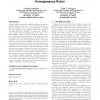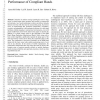5 search results - page 1 / 1 » The Utility of Evolving Simulated Robot Morphology Increases... |
ALIFE
2010
13 years 3 months ago
2010
Embodied artificial intelligence argues that the body and brain play equally important roles in the generation of adaptive behavior. An increasingly common approach therefore is to...
GECCO
2009
Springer
13 years 11 months ago
2009
Springer
Embodied cognition emphasizes that intelligent behavior results from the coupled dynamics between an agent’s body, brain and environment. In response to this, several projects h...
GECCO
2009
Springer
13 years 11 months ago
2009
Springer
A central tenet of embodied artificial intelligence is that intelligent behavior arises out of the coupled dynamics between an agent’s body, brain and environment. It follows t...
AROBOTS
2010
13 years 4 months ago
2010
Limitations in modern sensing technologies result in large errors in sensed target object geometry and location in unstructured environments. As a result, positioning a robotic end...
ICRA
2010
IEEE
13 years 3 months ago
2010
IEEE
— Data collection using Autonomous Underwater Vehicles (AUVs) is increasing in importance within the oceanographic research community. Contrary to traditional moored or static pl...


